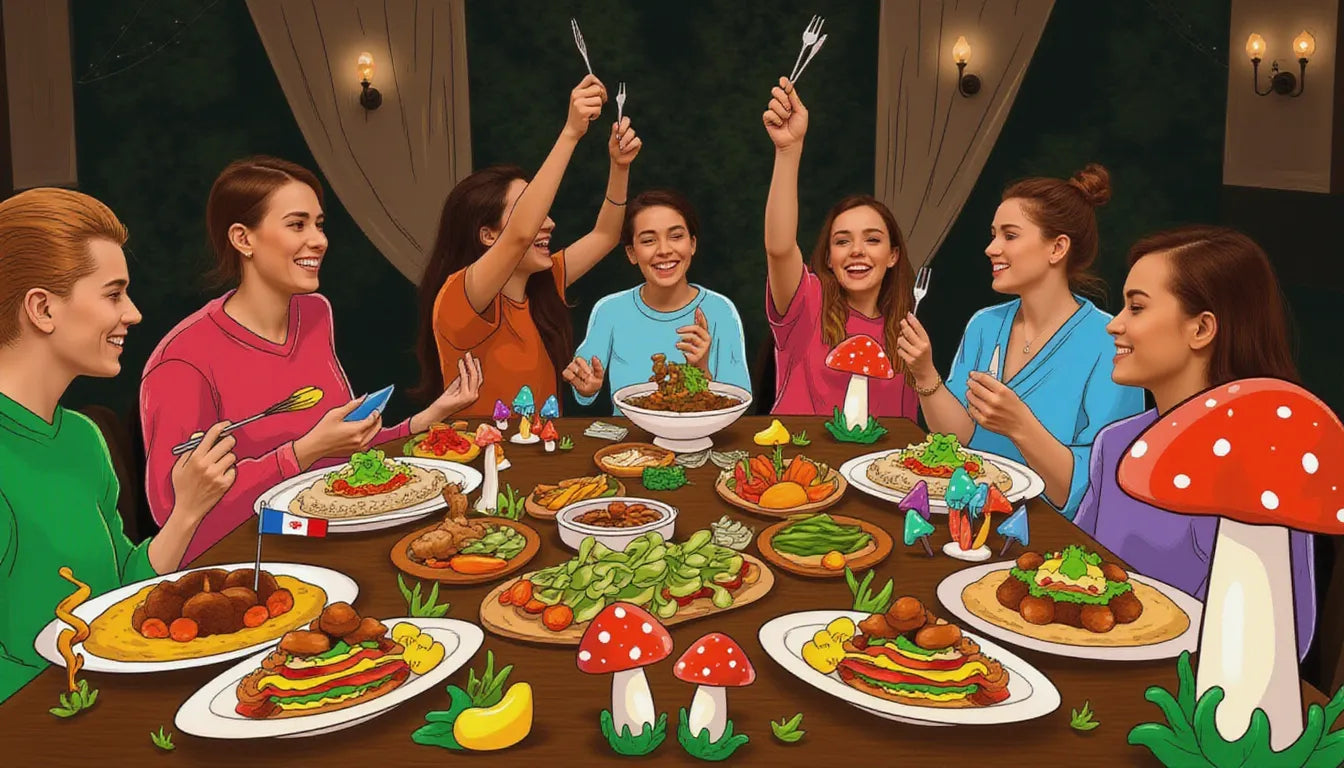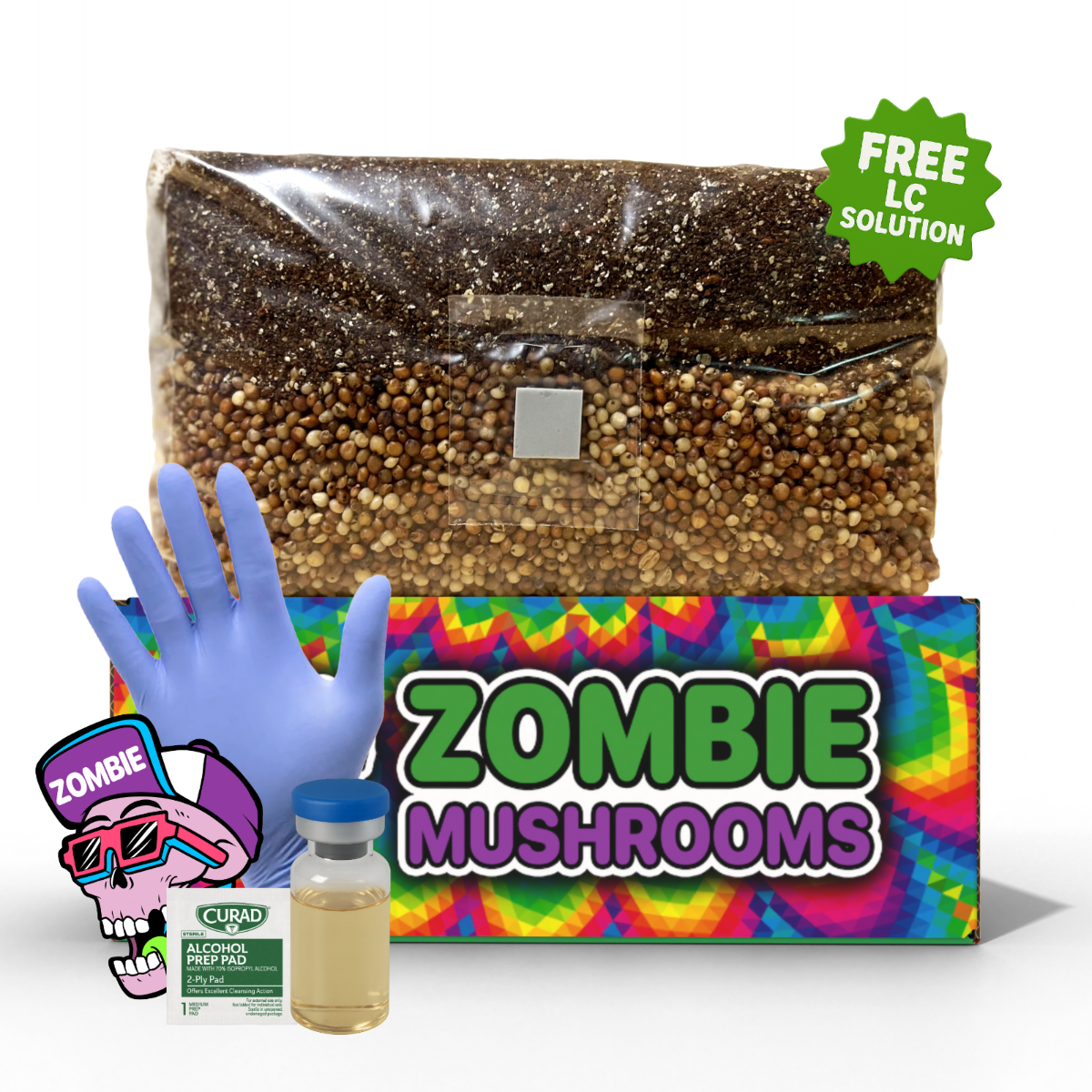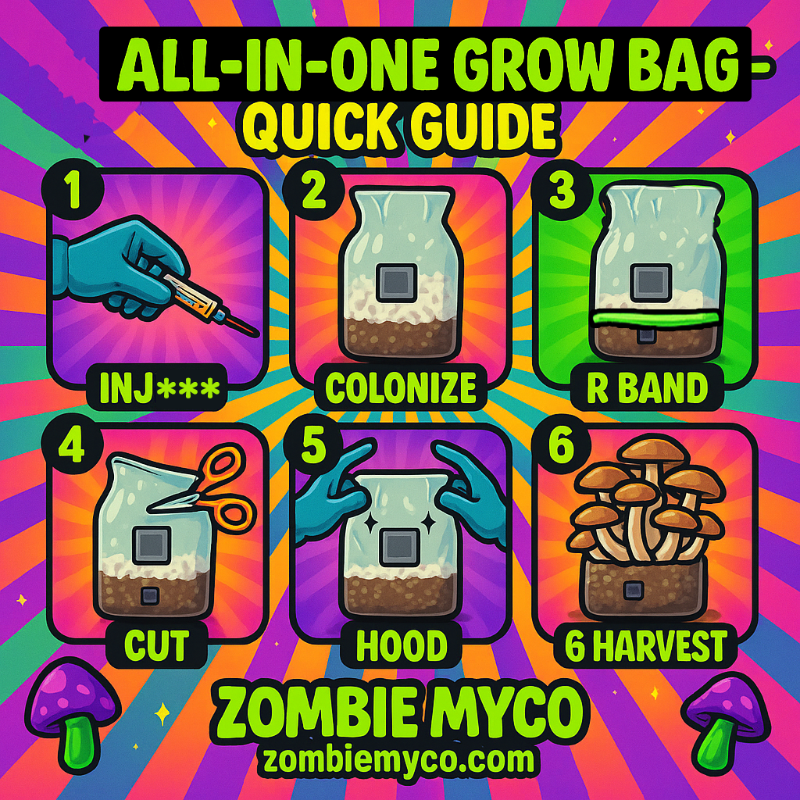⬇️ Prefer to listen instead? ⬇️
- Mushrooms are used in nearly every country's cooking and are deeply tied to cultural identities.
- They are among the most sustainable food sources. They need less land and water and make fewer greenhouse gases.
- Shiitake, Porcini, and Oyster mushrooms are the main ones used in cooking in different places because they taste strong and you can use them in many ways.
- People still use mushrooms for medicine and ceremonies today. This comes from old ways of different groups and traditions.
- Ways of cooking like stir-frying, grilling, and slow-cooking bring out special mushroom flavors in different cultures.

Why Mushrooms Are a Global Ingredient
Mushrooms are special in cooking around the world. People like their deep umami flavor, and they are also good for you and the environment. They don't have many calories but have lots of B vitamins, selenium, potassium, and fiber. This makes them a wanted ingredient for people who care about health and for traditional cooks. With our easy-to-use grow bags, you can enjoy fresh, nutrient-rich mushrooms right from home
Using mushrooms in cooking has also become more popular lately. This is because people know more about their small impact on the environment. They need less water and grow well on reused farm waste. And, they also make fewer greenhouse gases than meat. This makes them a great choice instead of meat and a sustainable food source everywhere.

Mushrooms in Asian Cuisine: A Cultural Staple
In many Asian cultures, mushrooms are basic to cooking and even medicine. How much Asian cooking uses mushrooms shows old cooking and healing knowledge.
-
Japan: Japanese dishes are often simple to show off how ingredients taste. Shiitake mushrooms taste rich and smoky. They are a basic part of miso soup, nabemono hot pots, and even grilled yakitori skewers. King Oyster mushrooms are liked because they feel meaty. People slice and cook them like steak or put them in nimono (simmered dishes).
-
China: Using mushrooms in Chinese cooking is not just about taste. It's also for health. For example, Wood Ear mushrooms (Auricularia auricula-judae) are used in cooling dishes. They are thought to help clean the body. Shiitake and Black Mushrooms are cooked slowly with bok choy, tofu, or pork belly in tasty sauces. In Cantonese dim sum, steamed dumplings often have chopped mushrooms inside for a deep umami taste.
-
Korea: Korean cooking uses mushrooms a lot in soups, stews, and barbecues. Beoseot-jeongol is a great hot pot. It has layers of shiitake, oyster, and enoki mushrooms, tofu, and scallions in a spicy gochujang broth. Also, people grill mushrooms and serve them with ssamjang, a bean chili paste, for Korean barbecue.
-
Thailand & Vietnam: Oyster mushrooms are often in tom yum soup, green curries, and vegetarian spring rolls. People use them with lemongrass, makrut lime leaves, and fresh herbs. This makes flavorful dishes that smell good. Vietnamese bun rieu chay, a vegetarian broth, uses mushrooms instead of crab for depth and protein.
Asian kitchens use mushrooms not just as fresh food but also dried, fermented, or powdered. This makes them useful in more ways in cooking. It also fits with how cultures have always saved food.

Mushrooms in European Cuisine: Earthy and Elegant
European chefs think mushrooms are necessary. They use them in simple country cooking and fancy meals.
-
France: France is known for cooking that comes from the land, and it has a very strong link to mushrooms. Finding mushrooms in the woods when they are in season is a national hobby, especially for chanterelles and morels. People add butter, cream, garlic, and shallots to these. Then they pour this over chicken or pasta, or eat it on small toasts. Mushroom duxelles—small chopped mushrooms cooked with onions and herbs—is needed for Beef Wellington.
-
Italy: In Italy, cooking mushrooms like Porcini (Boletus edulis) are carefully dried. People use them to give risottos and sauces a great smell that is hard to match. Porcini risotto mixes this umami-rich mushroom with white wine and Parmesan cheese. Truffles are fungi but not mushrooms in how they are grouped. They smell great in pasta, polenta, and eggs. And, they cost a lot during fall festivals in Tuscany and Piedmont.
-
Eastern Europe: Finding mushrooms in the woods is part of the culture in Poland, Ukraine, and Russia. In Poland, people use wild mushrooms during Wigilia (Christmas Eve dinner) in barszcz (beet soup) and pierogi. In Russia, saved mushrooms in vinegar and spices are served as zakuski (small dishes before the meal). And, filling mushroom and barley soups make winter meals heartier.
-
United Kingdom: British cooking uses mushrooms in everything from pub food to fancy cooking. Small button and Portobello mushrooms are in full English breakfasts. Also, wild mushroom pasties and creamy chicken and mushroom pies are common in pubs. Mushrooms found in the woods are the main thing in seasonal menus across the country.
Mushroom cooking in Europe changes with the season and place. Often, it uses mushrooms found in the woods and old family recipes.

Mushrooms in Middle Eastern Cuisine: Spiced and Savory
In kitchens in the Middle East, earthy mushrooms add a filling texture and taste to old recipes and new ones.
-
Turkey: Cooked mushrooms are in mezze platters. Often, people mix them with sumac, parsley, and olive oil. Some types are spiced and mixed with bulgur to make vegetarian meatballs. Mushroom güveç is a liked stew made in clay pots.
-
Iran: Stews made with mushrooms, like Khoresht-e Gharch, have turmeric, dried lime, and barberries. This makes the simple mushroom taste savory and sour, and very good. People often eat them with saffron rice and yogurt on the side.
-
Israel: Israel's cooking has influences from many places, from North Africa to Eastern Europe. People use mushrooms in shawarma. Roasted Portobellos get rubbed with shawarma seasoning and cooked until they are crisp. Mushrooms are also chopped small for fillings in borekas, tasty pastries sold in bakeries and markets.
Mushrooms can be used instead of meat in vegan dishes from the Near East. People add strong spices like cumin, cinnamon, and paprika to make the taste stronger.

Mushrooms in Latin American Cuisine: Bold and Inventive
Latin American dishes use mushrooms with bright chilis, herbs from warm places, and old local cooking ways.
-
Mexico: Mushroom tacos (tacos de hongos) are a popular street snack. People cook them with garlic, epazote, and jalapeños. They taste smoky and have an umami flavor. Huitlacoche (Ustilago maydis), the well-known “corn smut,” is a special food. People cook it and put it in quesadillas, tamales, and even soups. It is not seen as a problem with corn. It is liked because it tastes deep like truffles (González, 2019).
-
Peru: Modern chefs mix cooking styles from the Andes and Amazon. They add mushrooms to dishes like causa and lomo saltado, especially in versions without meat. Ají amarillo is a fruity chili. It goes very well with mushrooms for spicy salads like ceviche.
-
Brazil: Versions of Moqueca—a seafood stew from the northeast of Brazil—are now made with plants and use mushrooms a lot. People cook them slowly in coconut milk with dendê oil, tomatoes, and peppers. Mushrooms are also used to fill tapioca crepes and pastelzinho fritters.
-
Chile: Mushroom empanadas, especially those with merkén (a smoked chili spice), are simple, filling, and often served at festivals.
Latin America shows that mushrooms work in both traditional and fancy cooking. They add an earthy depth to Latin tastes.

The Role of Indigenous and Medicinal Uses
Before cooking became more set, local groups around the world used mushrooms for spiritual reasons and for medicine.
-
Traditional Chinese Medicine: Reishi (Lingzhi) mushrooms are thought to make your immune system work better and help you live longer. Lion’s Mane is seen as good for the brain. They help protect the mind as people get older. Some studies now show this is true.
-
Mesoamerican Traditions: Local groups like the Mazatec in Mexico used psilocybin mushrooms in holy ceremonies. These fungi were seen as tools to understand things, heal, and connect with the spirit world.
-
Amazonian Cultures: Many tribes used wild mushrooms in rainforest healing rituals or for planning how to get food. We don't have writings about this for all of them.
-
Siberian and Arctic Communities: In Northern Russia and local Siberian tribes, mushrooms like Amanita muscaria were used in ceremonies. This included looking for visions, doing shamanic work, and sometimes, carefully and rarely, for changing how they saw things.
Many people are interested in medicinal mushrooms again for health today. People all over the world are buying liquids, powders, and pills made from them. These ideas come from old studies of plants and people.

Mushroom Types by Region & Culinary Use
| Mushroom Type | Region | Common Uses |
|---|---|---|
| Shiitake | Asia | Soup bases, stir-fried rice, ramen topping |
| Porcini | Europe | Risotto, pasta sauces, stuffing |
| Chanterelle | Europe | Grilled dishes, eggs, light cream sauces |
| Wood Ear | China | Soups, salads, cold dishes, stir-fries |
| Button | Global | Pizzas, omelets, casseroles |
| Oyster | Global | Vegan meat, barbecue skewers, curry |
| Huitlacoche | Mexico | Quesadillas, tamales, black mole |
This table shows the different kinds of mushrooms and where they are used. It is showing how well they can be used in cooking.

Cooking Techniques Around the World
Mushrooms change texture and taste a lot depending on how you cook them:
- Stir-Frying: This is very important in Asian cooking. It cooks mushrooms quickly and keeps them moist and bouncy.
- Slow-Cooking & Braising: This is common in Eastern Europe and Middle Eastern dishes. It makes mushrooms into smooth textures with rich umami flavor.
- Roasting: This makes them sweeter and their flavor stronger. It's good for shawarma and things cooked in the oven.
- Grilling: This is good with thick mushrooms like Portobellos or King Oysters. It works well for BBQs and sandwiches.
- Drying: This makes the smell stronger and the taste deeper. It's often done for European pasta and Asian broths.
- Fermentation: You find this in some Korean side dishes or very old spice sauces in Latin cultures.
These different ways of cooking show how mushrooms are used around the world for how they feel, taste, and fit old ways.

Pairing Mushrooms With Local Flavors
Putting mushrooms with the right flavors is key to good regional mushroom cooking:
- Japan: Miso or soy adds salty and umami flavors to earthy shiitake.
- Italy: Thyme, sage, red wine, and Parmesan make mushrooms into smooth pasta fillings or rich risottos.
- India: Cumin, garam masala, and coriander add spices to mushrooms to make filling vegetable dishes and curries.
- South America: Lemon or lime taste and spice from chili balance meaty mushrooms with brightness.
- Middle East: Using za’atar and cinnamon gives a warm, strong taste that is different from mushrooms' natural earth taste.
Mushroom dishes from around the world happen because cultures mix local food well with the natural umami in mushrooms.

Nutritional and Sustainable Benefits of Mushrooms Across Cultures
Cultural mushroom recipes come from both cooking and health traditions:
- In Okinawa, Japan, mushrooms are part of a diet that is linked to getting sick less often and living a long time.
- Mushrooms have lots of selenium, B-vitamins, and potassium. They help your heart and immune system stay healthy.
- Lions Mane mushrooms look promising for helping brain health. People are putting them in brain-boosting pills and health foods.
As food choices move toward sustainability, mushrooms are a great answer:
- Smith & Johnson (2021) say that mushrooms can grow up to 10 times more food that people can eat per square meter than farm animals.
- They grow well on farm waste (like sawdust or used grain). This is helping farming systems that reuse things.
So, mushrooms are good to eat, and they help the planet.

How to Grow Mushrooms at Home for Global Cooking
Zombie Mushrooms grow kits make it fun and easy to grow mushrooms for cooking at home. You don't need to be good at gardening.
- Oyster Mushrooms: These are great for stir-fried Thai dishes or creamy Italian sauces.
- Shiitake: These are good for Japanese soups and savory hot pots.
- Lion’s Mane: These look very cool and feel like crab. They are great in vegan crab cakes or stews.
Tips for growing and saving:
- Pick them right away when the top opens up for the best taste.
- Keep them dry. Wrap them loosely in paper towels and put them in the fridge.
- If you have too many, dry them. Then store them. They will add taste to broths and stocks later.
Growing mushrooms at home connects trying new ways to cook with old food traditions.

Easy Global Mushroom Recipes to Try at Home
Cook food from around the world in your kitchen with these easy mushroom recipes. They are inspired by different places:
-
Italian Risotto with Oyster Mushrooms
Cook onions and garlic in olive oil. Stir in Arborio rice. Add white wine to lift bits from the pan. Add broth a little bit at a time with sliced oyster mushrooms and Parmesan cheese. -
Korean Beoseot-Jeongol (Hot Pot)
Layer tofu, zucchini, shiitake, enoki, and napa cabbage in a hot pot. Add gochujang, garlic, and soy sauce. Cook slowly into a warm, spicy stew. -
Middle Eastern Mushroom Shawarma Wrap
Cook Portobello mushrooms in the oven. Rub them with olive oil, paprika, and cumin. Put them in pita bread with cut-up lettuce and tahini-lemon sauce. -
Mexican Huitlacoche Quesadilla
Mix huitlacoche and cooked onions with Oaxaca cheese. Put it in a warm corn tortilla and toast it. Serve with salsa verde.
Make them with mushrooms you grew yourself. See how good cooking with different cultures' mushroom recipes feels.
A Unifying Ingredient Across Cultures
Mushrooms are more than food, from the thick woods of Japan to the Andes Mountains and busy cafes in Paris. They are about how people cook. They feed people, help them heal, and bring them together. They show how food can be sustainable, change easily, and taste good to everyone. More people are cooking mushroom dishes from around the world. This shows how one natural food can be like our shared past and what we all like to eat.
Want to try cooking mushrooms from different places? Start with Zombie Mushrooms’ recipe-focused grow kits. It's a way to taste amazing flavors and cook food from everywhere, right from your kitchen.



